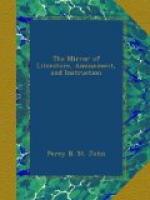THE ADMIRALTY-OFFICE.
The Admiralty Office, Whitehall, has few pretensions to architectual beauty. It is, however, to use a common phrase, a commanding pile, and its association with Britain’s best bulwarks—her Navy—renders it an interesting subject for representation.
The Admiralty-office adjoins to the north side of the Horse Guards, and was erected by Ripley, in the reign of George II., on the site of Wallingford House. It recedes from, but communicates with, the street by advancing wings, and is built principally of brick. In the centre of the main building is a lofty portico, of the Ionic order, the taste of which is not entitled to much praise. It consists of four columns, and on the entablature is an anchor in bold relief. Here are the offices, and the spacious abodes of the lords commissioners of the admiralty, together with a handsome hall, &c. On the roof of the building is a Semaphore telegraph, which communicates orders by signal to the principal ports of the empire.
But the most tasteful portion of the whole, is a stone screen, by Adams, in front of an open court, and facing the street. The style is exceedingly chaste and pleasing, and the decorations are characteristic naval emblems, finely executed. The representation of two ancient vessels in the end entablatures, merit especial notice.
Since the appointment of the Duke of Clarence to the office of lord high admiral, the Admiralty has been the town residence of his royal highness. The exterior has been repaired, and the interior in part refitted. The screen has likewise been renovated with much care, and two of the entrances considerably enlarged, but with more regard to convenience than good taste. The portion occupied by the royal duke contains a splendid suite of state rooms, within whose walls have frequently been assembled all the bravery, as well as rank, of the empire; for the interests of the noble service are too dear to his royal highness to be eclipsed by the false lights of wealth or fashion.
* * * * *
HUITAIN DE CLEMENT MAROT.
(For the Mirror.)
Plus ne suis ce que j’ay este
Et ne le scaurois jamais estre,
Mon beau printemps et mon este
Ont fait le saut par la fenestre.
Amour! tu as este mon maistre
Je t’ai servi sur tous les Dieux,
O si je pouvois deux fois naistre,
Comment je te se virois mieux!
Imitation.
I am no more, what I have been
And ne’er again shall
be so.
My summer bright, my spring time green,
Have flown out of the window.
Oh love, my master thou hast been,
I, first of gods, instal thee,
Oh! could I e’en be born again,
Thou doubly would’st
enthral me.
D.M.
* * * * *




